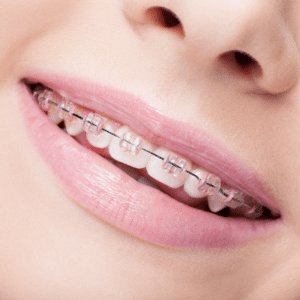At Midlands Orthodontics, we know from our years of orthodontic practice that most patients who opt for traditional braces have some concerns about potential discomfort or pain during their treatment. Dr. Buddy and his team are dedicated to making your course of orthodontic treatment as smooth and painless as possible; and we believe that well-informed patients are happier patients. Let’s review the various stages of treatment with traditional braces, so you know better what to expect.
The First Day You Get Braces 
When braces are initially placed on your teeth, you usually will feel no pain. You may feel a bit of discomfort, as you will need to keep your mouth open for intervals while your orthodontist carefully arranges the architecture of brackets and wires which ultimately corrects your bite.
Several steps are involved:
- Drying your teeth.
- Applying glue.
- Attaching metal brackets in the center of each tooth.
- Connecting the brackets with arch wires.
Your First Week of Wearing Braces
This adjustment period typically causes some discomfort and an achy feeling in your teeth because your teeth are starting to align. You may feel a low-grade, steady pressure from the wires. The pain is not acute, but it can be annoying. The upside is that you can feel your braces working: your bite is already being brought into better alignment.
For relief, your orthodontist generally recommends:
- Taking an over-the-counter analgesic you know you can tolerate.
- Rinsing with warm salt water.
- Eating soft foods such as yogurt, applesauce, pasta, and scrambled eggs.
- Avoiding acidic foods and drinks.
Some orthodontic patients develop mouth sores as they adjust to traditional braces. You can address this temporary challenge in two ways:
- Applying orthodontic wax over the metal area which is bothering you. Your orthodontist will teach you this technique and send you home with a supply of wax.
- Painting the sore area of your cheek with an over-the-counter oral anesthetic to ensure temporary numbness. This may help you fall asleep at night.
At each orthodontic appointment, adjustments are made to your braces to make your teeth move properly. Some typical adjustments in the course of treatment include:
- Configuring (bending) your arch wires differently.
- Exchanging heavier arch wires for lighter ones; or vice versa.
- Attaching elastic rubber bands of various lengths (and your choice of colors) to special hooks on your braces. Elastics usually stretch from the top to bottom jaws to correct malocclusions such as crossbite; and to move your teeth properly must be worn 24/7 except for eating and brushing your teeth.
These adjustments may cause discomfort for a few days after the appointment, as your teeth realign. Again, an over-the-counter pain reliever that works for you can be used occasionally to relieve any pain or bothersome discomfort.
Your First Six Months
Most orthodontic clients report they have acclimated to their braces within their first month. After six months, patients reach a point where they don’t usually notice their braces except to practice the specific oral hygiene care routine — including brushing and flossing after meals and avoiding certain sticky or hard foods — recommended to keep teeth healthy while wearing braces. And, of course, to change elastics if your orthodontist has prescribed them.
The short periods of discomfort from wearing braces are manageable and well worth the time and effort you and your orthodontist invest in your orthodontic treatment. You will pat yourself on the back every time you see your increasingly attractive, straight, healthy smile in the mirror.
At Midlands Orthodontics, we look forward to helping you correct your bite for a lifetime of healthier, happier teeth. Please contact us at (803) 402-3838 or schedule your complimentary consultation online.

